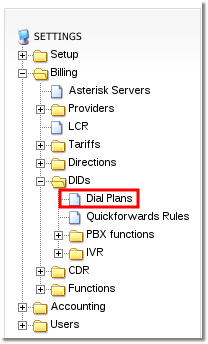Callback setup example
This example will demonstrate the basic steps needed to make a calling card callback setup:
In order to accomplish this you will need:
a) Two DID numbers (one can be fake)
b) One tariff for callback
c) One user + device for callback
d) Two dial plans (or more), one for callback and one for Calling card/authorization by PIN/ANI.
1. Let's create a Callback User:
2. When you create a callback user make sure to assign a correct Tariff for the callback.
Our suggestion is to include only those destinations in the tariff from which clients will be calling to the callback.
3. Now, let's add a Callback Device:
The Device's settings are not at all important – leave everything empty. They will not be used, anyway.
You can even create a Virtual device for this service.
5. Calling Card or Authorization by PIN dial plan should be created depending on your needs:
Open dial plans menu:
Create a calling card dial plan:
Assign the dial plan to the DID through which it will be reached in the DIDs menu.
Important! This Dial Plan are active by themselves. That is, dialing the associated DID, you will get the service described by this Dial Plan. Callback is not configured yet.
6. Now we will create a Callback Dial Plan:
7. Save the dial plan and edit the settings, you will be forwarded to this page:
And in the Dial Plan section, the same information is given in another perspective:
See also:







